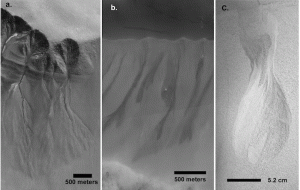Gullies on Martian slopes form by flowing water, most probably trickles of snowmelt or groundwater. But what about the gullies found in places such as the high latitudes and polar regions where temperatures never rise above the freezing point for water?

GROOVY GULLIES. Bright frost has collected (left) on slopes facing away from the Sun in a southern polar pit (latitude 68.5° south). At center, dark streaks mark where gullies lie in on a dune at 70.3° south. At right is a gully formed experimentally with gas fluidizing dry sand. (Image is Figure S1 from the paper.)
A new paper in Geophysical Research Letters offers flows of carbon dioxide gas as the eroding fluid instead of liquid water.
Yolanda Cedillo-Flores (Universidad Nacional Autonoma de Mexico) and three other planetary scientists propose that CO2 gas could pick up and carry loose sediment (sand and dust-size particles) downslope, eroding small gullies. The CO2 would come from seasonal frost that sublimates (passes from ice crystals directly into a gas) as local spring arrives.
“For polar gully landforms to be initiated by fluidization of CO2, slopes mantled in annual CO2 frosts must be covered by sediment, sand, or dust,” they explain. This can be met only under restricted conditions: “It requires a pole-facing slope (such as a crater wall or dune) to develop a seasonal cover of CO2 frost. Surface winds could then cause sediment to blow in from nearby equator-facing slopes and be deposited on the frosted pole-facing slopes, thus burying the CO2 frost beneath the sediment.”
At that point, the stage is set. When the Sun starts shining on the slopes early in local spring, solar heat is absorbed by the sediments and conducted into the underlying CO2 frost. This sublimates in response. And if gas velocities in sublimation become high enough, the overlying sediment can be fluidized and flow downhill, starting the erosion of a gully.
The scientists caution that gullies in polar and temperate latitudes show similar ranges of sizes and shapes, consistent with formation by a common mechanism. However, they note, “Similar gully morphologies can also arise in liquid-rich flows which suggests that gullies can be initiated by multiple processes — and that, once begun, the flow process in gully-forming avalanches is independent of how the flow was initiated.”








